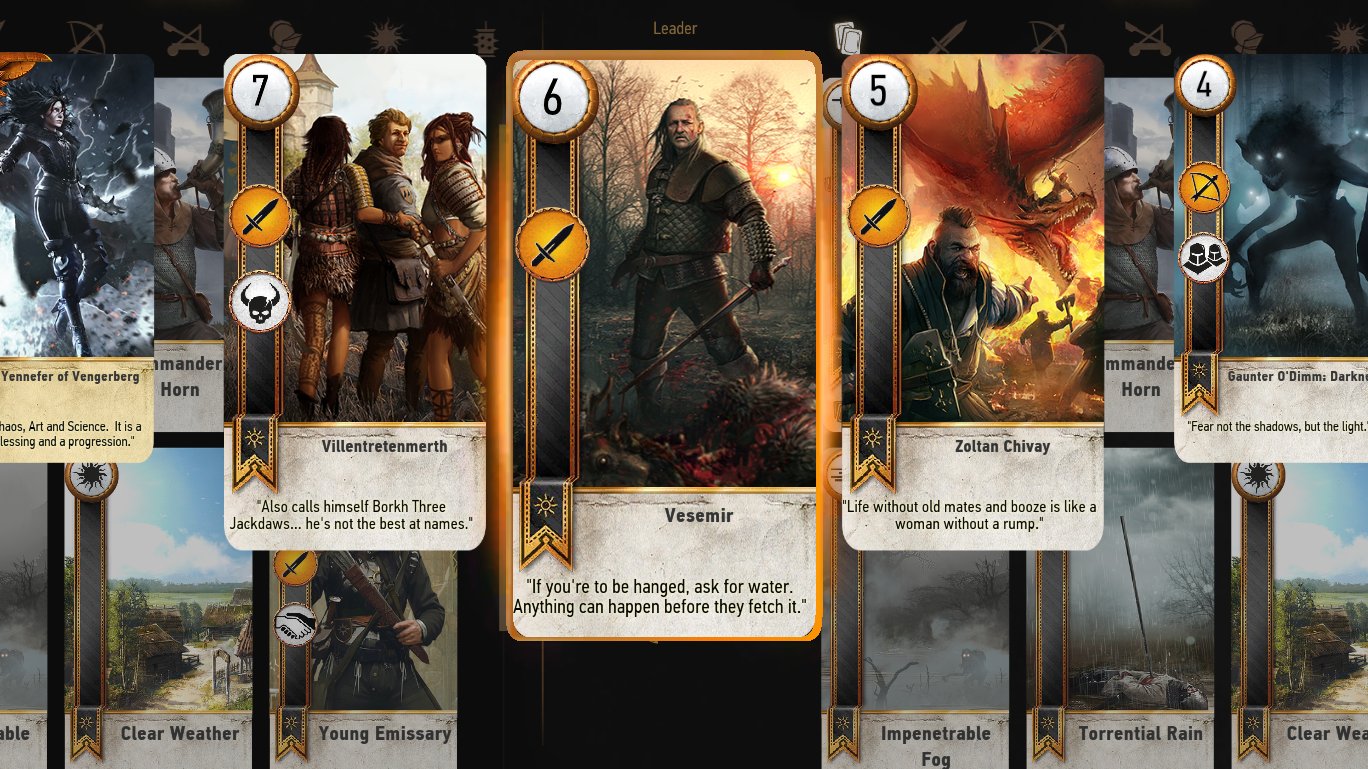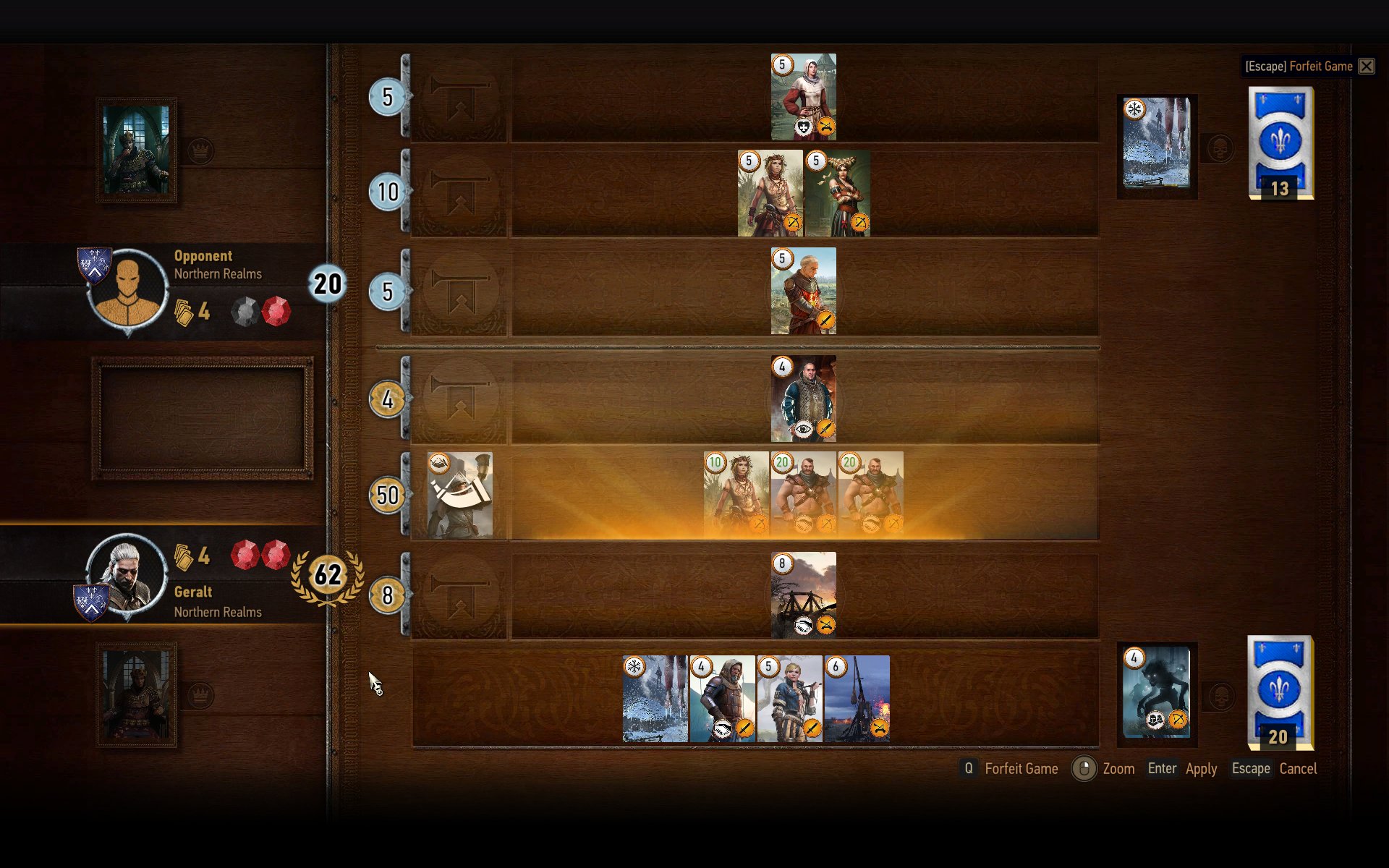The making of Gwent

I’ve never been so singularly obsessed with a minigame as I am with Gwent, The Witcher 3: Wild Hunt’s delightfully clever in-game card battler. Despite a simple point-based, best-of-three structure, it’s richly tactical—with an elegant ruleset that, for all its depth, never feels overwrought. It sits so naturally inside the game’s world that you’d be forgiven for thinking it was a major part of The Witcher 3’s development. That, it turns out, was not the case.
Gwent was created by a small group within The Witcher 3’s development team. “[We] had to implement the game as well as work on some other areas of Wild Hunt,” says Damien Monnier, senior gameplay designer. In previous Witcher games, Geralt could wind down with a few rounds of Dice Poker—a relatively simple minigame that transposed poker hands onto dice rolls. “We wanted to try something new,” says Monnier. “Wild Hunt was a way for us to push all other aspects of our previous titles to the max—from storytelling to gameplay, the quality of quests and the art. It just didn’t feel right to bring back a game that we felt we could not really improve on.”
The Gwent team’s ambition caused difficulties, however. “Very early on,” Monnier says, “we agreed that if we were going to do something, it really had to be fun and on the same level as the rest of the game.” However, CD Projekt RED hadn’t budgeted for a minigame of that size, meaning much of Gwent was created and polished during the core team’s spare time. This was no small undertaking. At launch, The Witcher 3 had 195 unique Gwent cards, all of which needed prototyping, designing and testing.
“A producer usually says something like: ‘And you need how many cards and concepts done?!’” Monnier says. “‘Who is going to draw all this?!’” Luckily, Gwent’s creators were able to enlist help from others within The Witcher 3’s development team. “Anyone who could help played the prototype with us and was on board instantly. We got help from our art crew, and even from the marketing department, who helped with UI design. It really was a massive team effort.”

Lead UI programmer Jason Slama recalls the moment he realised Gwent was worth the extra work. “The first thing I did was play the paper prototype that had already been made,” he says. “After about two matches, I started seeing its potential as a great game and began drafting a plan that would enable us to fit it in our tight schedules. We were all so busy just trying to get the main game done—I’m still super impressed with the results we achieved. We had some great people from all disciplines chip in and it wouldn’t have been possible without their support.”
At the most basic level, Gwent is a game about playing cards to create a higher score value than your opponent. It’s also a game about bluffing—attempting to trick your opponent into overcommitting to a hand, thus exposing a flaw in their composition or, even better, leaving them with fewer cards for subsequent hands.
After about two matches, I started seeing its potential as a great game.
Beyond that, though, there’s an excellent tactical breadth that emerges through special cards and abilities, and the way these can be combined. If your opponent plays a spy to your board, for instance, you’ll receive that card’s points, but they’ll draw an additional two cards to their hand—a potentially powerful advantage. But by using a Decoy, you can recall and replay the card, giving your opponent the points, but taking two cards to your own hand. It’s elegant intricacies like this that make Gwent such a wonderfully enjoyable distraction.
The biggest gaming news, reviews and hardware deals
Keep up to date with the most important stories and the best deals, as picked by the PC Gamer team.
“The prototype phase was done with [CD Projekt RED business development manager] Rafał Jaki, who is a massive card player and my boardgame sidekick,” Monnier says. “We would bounce card ideas [off each other] and the rule was if you have to explain it twice, then it’s probably too complicated.” Abilities that made the cut, such as Tight Bond—‘when there is another copy of this card on the board, their values are doubled’—have a simple, easy to parse effect. “The thing about Gwent is mostly bluffing and card management between rounds,” Monnier says. “The abilities are layered over that.”

Phil has been writing for PC Gamer for nearly a decade, starting out as a freelance writer covering everything from free games to MMOs. He eventually joined full-time as a news writer, before moving to the magazine to review immersive sims, RPGs and Hitman games. Now he leads PC Gamer's UK team, but still sometimes finds the time to write about his ongoing obsessions with Destiny 2, GTA Online and Apex Legends. When he's not levelling up battle passes, he's checking out the latest tactics game or dipping back into Guild Wars 2. He's largely responsible for the whole Tub Geralt thing, but still isn't sorry.

